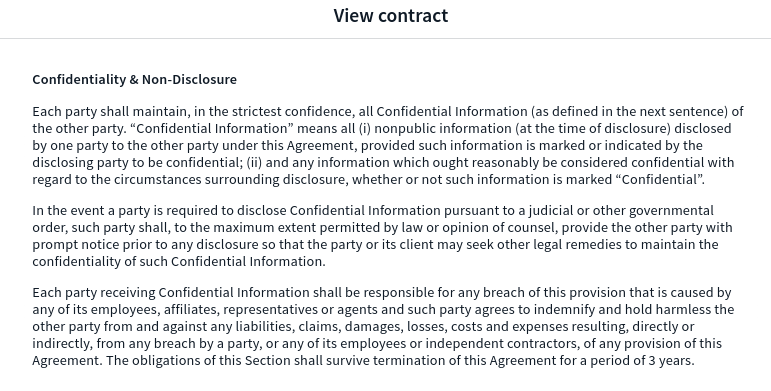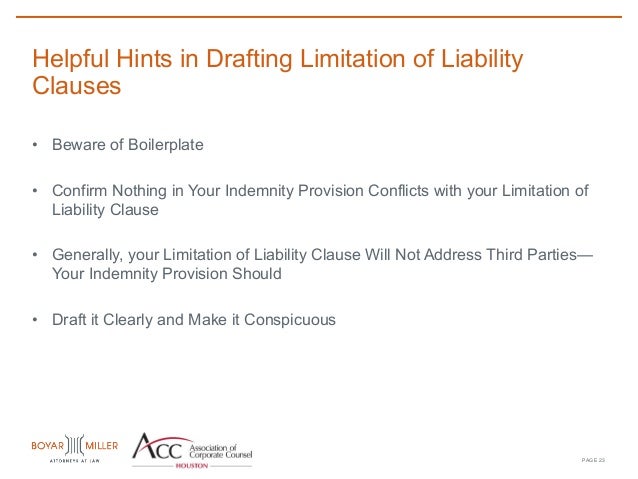
Are indemnification provisions enforceable? What is the purpose of indemnification clauses? View the complete version here. However, enforceability of such a clause will depend on the actual language used to shift the respective parties’ liability burden. Generally, indemnity agreements in construction contracts are a promise by which one party (the indemnitor) agrees to defen indemnify, or hold harmless the other party (the indemnitee) for acts or omissions related to the project.

The enforceability of indemnity agreements is a battle that will likely ignite , if construction litigation arises. This article is intended to map out the legislative landscape of indemnity statutes across the country, as a resource to determine whether the. An indemnity clause, also known as an indemnification clause, is a standard waiver clause that states that one party won’t hold the other liable for damages , losses , or costs associated with incurred legal issues. For liability waivers, these potential costs are typically the loss, damages, or other legal costs that would arise from a lawsuit.
An indemnification provision, also known as a hold harmless provision, is a clause used in contracts to shift potential costs from one party to the other. In a mutual indemnification, both parties agree to compensate the other party for losses arising out of the agreement to the extent those losses are caused by the indemnifying partys breach of the contract. In a one-way indemnification, only one party provides this indemnity in favor of the other party.
The primary benefit of an indemnification provision is to protect the indemnified party against losses from third party claims related to the contract. They are typically used in agreements where the risks associated with a partys non-performance, breach, or misconduct are high. For example, agreements that involve the sale of intellectual property rights often include an indemnification by the seller in order to protect the buyer against the potentially large liability associated with an infringement lawsuit by a third party. See full list on nolo.
The following is an example of a basic mutual indemnification provision. Remember, any indemnity must be tailored to your specific needs. Lets say you commission a writer to prepare a speech for you on a work-for-hire basis. Instead of delivering an original speech as promised under the contract, the writer incorporates passages from a speech by another person who then sues you for copyright infringement, claiming that his intellectual property was exploited without his consent. Your agreement with the writer includes a representation and warranty that the work product provided under the contract is original.
It also has a standard indemnification provision that promises to hold you harmless from any losses or damages, including attorney fees, incurred as a result of any breach of the agreement. Pursuant to the indemnity , the writer would be obligated to handle the legal defense related to the other writers intellectual property infringement lawsuit against you and cover all of the losses and expenses you incur as a result of the infringement claim. You would want to include additional language depending on your circumstances. For example, an indemnification can be limited to specific third party claims (such as those related to a breach of warranty), or restricted to only those situations where a lawsuit has been filed or a final judgment has been rendered.
If you are the party providing the indemnification, you will want to make sure the clause is as narrowly tailored as possible to protect against the specific risk it is intended to protect against. There are certain exceptions however. Certain states also prohibit indemnification provisions that provide for punitive damages. Check all applicable laws before drafting an indemnity.

Additionally, courts have commonly held that a plaintiff may not recover damages under an indemnity clause to the extent that the damages are an unforeseeable and improbable outcome of the other partys breach, negligence, or misconduct (unless it can be shown that the indemnifying party had knowledge of the relevant circumstances). They should be broad enough to sufficiently address the parties concerns, yet reasonable and equitable in all respects so that their enforceability is not called into question. Indemnity Agreements as Insured Contracts. At a certain level of sophistication, contracting parties begin incorporating indemnity provisions in their contracts as a risk-assignment mechanism. Without input from knowledgeable counsel, these provisions can impose an unexpected burden on unsuspecting parties, fail to offer the protection sought by the provision’s proponent, or lull the parties into believing that insurance is unnecessary or redundant.
Standard Clauses assume that the agreement’s seller, supplier, or service provider is the indemnifying. The indemnification also gives University a right to select its own counsel. Far better, therefore, to draft expressly and make it clear (either in the indemnity clause , or the limitation of liability clause ) whether or not the agreement cap limits the indemnity. You should also consider whether any sums paid under a specific indemnity count towards or use up the agreement liability cap. Most indemnity clauses do not include reimbursement of the design professional’s costs and attorney’s fees spent enforcing a recalcitrant contractor to abide by the terms of the clause.
The general question presented is consequently simple: Is the indemnity agreement enforceable and what is its impact on the insurance obligation? Instant Downloa Mail Paper Copy or Hard Copy Delivery, Start and Order Now!
No comments:
Post a Comment
Note: Only a member of this blog may post a comment.